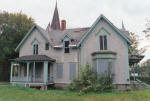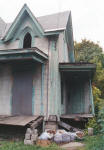Gothic Cottage1631 S. Salina |
Former 'Doctors Row' home at death's doorCity house on former 'Doctors Row' at death's doorThursday, August 04, 2005 Dick Case, Neighborhoods If the walls at 1631 S. Salina St. could talk, they'd tell us they hurt. This venerable Syracuse neighbor, a dozen blocks south of downtown Syracuse, slowly disintegrates before our eyes. It's been on the lot 150 years, and more. From 1874 to 1887, this city neighborhood was a village called Danforth, after Asa, one of our pioneers. No. 1631 has been an empty shell for years. It used to be the home of the Lynch family, who lived there more than 30 years in the 1900s. No one seems to know what to do with this relic of early Syracuse. "It's in limbo," according to Dennis Connors, curator of history at Onondaga Historical Association. Dennis, with others, has watched as the national landmark went to ruin.
George Lynch was a doctor in general practice. His office was at the south side of the house. Charlie Lynch provided the OHA with information and pictures of the house during the Lynch era. He connected me to his aunts in Florida. Irene Lynch and Helen Petrina grew up in the cottage, which is one of a few examples of this style of architecture left in town. "We always loved that house," Irene Lynch said during a phone chat I had from her home in West Palm Beach. She's sad it's gone the way it has. Historians date the house to 1850 to 1855. We aren't sure who built it, but Irene Lynch thinks her father bought it from the Longstreet family. Previous owners may have been doctors as well; George Lynch sold the place to a chiropractor when he retired in 1948 and moved to DeWitt. "That was Doctors Row down there," Helen's saying, recalling at least four others who practiced medicine in the neighborhood between Kirk, McLennan and Borden avenues. One time, the Lynch children found bones buried in the backyard. They figured they had been put there by a doctor who lived there. Irene's bedroom had a skull on the bookcase. When I asked, she easily recalled details of the house and yard: There were four bedrooms, a spiral stairway to the second floor, fireplaces with marble mantels. Patients entered the doctor's office by using a side porch; inside there were a waiting room and a small bathroom, which the family shared with patients. Irene rhapsodizes about the place she called home until she left for college in 1946. Especially the large yard, which ran behind the house to the slope of backyards of families on South State Street. "My father had fruit trees and a grape arbor," she explains. "We had pears, apples, peaches. There was a rose arbor along the driveway, a flagpole and a big space to play baseball." Among her neighborhood playmates were the "Fiore kids" who lived next door. The Kelleys were on the other side. All of the Lynch children became professionals: Irene was a nurse, her sister Helen a chemist. One brother, Charles, was a doctor, another a dental surgeon. Across Salina Street, at 1730, is the Eastlake/Stick Style house that also survives from the Danforth village era; it's in much better shape. The elegant place, with a carriage house, recently was the home of educator Jane Byrnes. It was built in the 1870s by the Kirk family. William B. Kirk, the builder, and father of a Syracuse mayor, in 1843 bought the undeveloped state land that became Danforth, and later part of Syracuse, and subdivided it. The Kirks are the namesakes of the park and the street. The Kirk place is what helps make this piece of South Salina Street a National Register historic district. The Gothic cottage has been owned the last 30 years by its next-door neighbor, New Jerusalem Church of God in Christ, the former Danforth Congregational Church. In 2004, the pastor, the Rev. James T. Jones, told me the church bought the house intending to turn it into a center for the congregation, but never did; upkeep on the 1884 church is an ongoing challenge. Three years ago, the Model Neighborhood agency, another neighbor, came up with a plan to rehabilitate 1631 as a one-family home. The agency couldn't justify spending an estimated $260,000 to save the building; the dream died. "It's an eyesore," the pastor said to me. "The city needs to tear it down." That's not easy, since this is a designated historic district. The city would have to prove to state preservation officials that this contributing element to the district is a threat to public safety. Jim Blakeman, the city's codes enforcement director, said this week 1631 isn't "in the pipeline for demolition because of its historic nature. It is among the vacants around the city we monitor." The landmark keeps slipping away from us. The front porch is the latest loss. In time, it will fall down. "It was such a pretty place," Irene Lynch says of her girlhood home. "It breaks my heart to see it now." Dick Case writes about neighborhoods every Thursday. Reach him at 470-2254, or by e-mail, citynews@syracuse.com. © 2005 The Post-Standard. |






